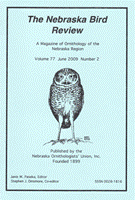Nebraska Ornithologists' Union

Nebraska Bird Review
Date of this Version
3-2025
Document Type
Article
Citation
Nebraska Bird Review, volume 93, number 1, March 2025, pp. 2–21.
Abstract
Since I started a few years ago to compare each season’s reports with the status of each species as presented in BONO (Species Accounts – Birds of Nebraska – Online), I had expected that “Routine reports” would apply to an increasing number of species as the BONO database firmed up, but this hasn’t happened. My comments from last winter continue to be valid this winter, now for the third winter in a row: As was the case for winter 2022–2023, the big general story was the large number of reports of tardy fall migrants and unexpectedly northerly occurrences in mid-winter… As reflected in this report, winter distributions continue to change and evolve, apparently as a result of more amenable winter conditions for many (most?) species that tend to be later fall migrants. The effects show mostly in terms of presence and numbers, both of which continue to increase but at a different rate for each species. I should point out that “winter” or “mid-winter” is defined differently for each species, and true winter status is judged against midwinter status per BONO data.
Generally rare midwinter occurrences applied to around 30 species, several of which were waterfowl but across a range of “half-hardy” passerines such as American Pipit, Song Sparrow, and blackbirds. These occurrences included several examples of higher numbers than usual, especially of waterfowl; reports were of record winter numbers of Tundra Swan, 36,640 Mallards on the DeSoto NWR CBC, 800 Greater Scaup, and a mind-boggling 9000 Common Goldeneyes at Gavins Point Dam. Encouraging numbers were reported as well for Red-shouldered Hawk, Short-eared Owl, Pinyon Jay, and Dark-eyed (Oregon) Junco. Even a few species that push early limits in spring provided interesting occurrences; a record early egg date (in January!) for Rock Pigeon, and Turkey Vulture arrivals in February.
On the other hand, low numbers were reported for a few species, notably the “winter finches” and Red-breasted Nuthatch, although these lows might also be attributed to “easier” conditions in their normal winter ranges, obviating the need to disperse or erupt. No Redpolls were reported, and Red Crossbill numbers were so low that the peak count at Wildcat Hills Nature Center, Scotts Bluff County, was only three! Oddly, the only White-winged Crossbill reported was a freshly dead female/immature. A special case for low numbers is Common Merganser, which has largely vacated its former winter stronghold at Harlan County Reservoir in Harlan County.
A few species generally rare in the Panhandle in midwinter were reported. Surprising were a Winter Wren in Sioux County, confirmed by audio, as well as Eastern Bluebird, Harris’s Sparrow, and Spotted Towhee. Gray Partridge was reported from Box Butte Co and near Valentine, Cherry County but not in the northeast.
Clearly the rarity of the season was “the” Couch’s Kingbird, found by Robert and Christine Nelson in Lincoln County, seen by many and confirmed by recording. Less spectacular but still noteworthy were two Brants and a Eurasian Wigeon as well as the aforementioned White-winged Crossbill.
The usual seasonal oddities were reported: a hybrid Cackling x Greater White-fronted Goose photographed with its parents, an urban Sandhill Crane in Lincoln, the 3rd consecutive winter for a hybrid Red-tailed x Rough-legged Hawk in Sarpy Co, and the transmitter-revealed wandering of a young Ferruginous Hawk.
All in all, an interesting season.
Included in
Ornithology Commons, Population Biology Commons, Poultry or Avian Science Commons, Zoology Commons


Comments
Published by the Nebraska Ornithologists’ Union, Inc.